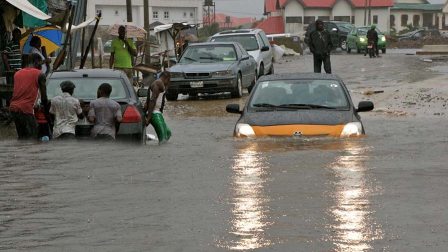dear Motorists,
Welcome to another special edition of Motoring advice brought to you only on Motoring World International. As you were reminded last week, raining season is knocking on the door.
And talking about the usual Nigerian experience, it is a period, when highways could turn to waterways, especially in cities like Lagos. It is a period when a vehicle could easily give up inside a pool of flood.
When the road becomes flooded, therefore, what should you do to drive through without much stress?
When the Flood is not too Deep: Any vehicle can be driven through a flooded road that is not up to 2-feet in the depth of water or the height of the water does not reach up to kneel of a 5-feet tall adult. Even a flooded road with lower depth could still frustrate a careless motorist.
General Rule: When driving through an unfamiliar road and it begins to rain, please reduce your speed, so that you won’t speed into a pool of water. For you might spray your car electrics or damage your engine. You might also spray water onto the windscreen of vehicles of other road users, a situation which could lead to an accident.
Driving through the Flood: Even if it’s a familiar road and it begins to rain and flood, slow down. When you get to a flooded part of the road and need to wade through, please do as follows:
Stop your car completely. If you can view the kerbside of the road, then it is not too deep. If you can’t, it is deep. If driving through a badly damaged road in which case there is likely to be deep ditches at certain points, drive carefully and slowly. And when you reach a point at which vehicles are breaking down in the pool and the point is obviously deep, turn back if you can.
If you must keep going, stop and observe other vehicles passing through. If there are no other vehicles passing, get out of the car, using your umbrella ( It is advisable to always have an umbrella or raincoat in your car during this season). Get a long stick to check the depth of the flood. If the depth level is as high as the hip of a five feet tall adult, it advisable not to drive through, unless your car is a Sports Utility Vehicle (SUV) or truck with high ground clearance.
If the water depth is not as high as 2-meter and you intend to keep going, do as follows:
- Put on the hazard light
- Switch off your air-condition so that the engine fan blade will not spray water on the electrics
- Wind downside glasses for fresh air
- Use the highest gear (gear 01)
- Drive through slowly at a steady speed but with high acceleration
- Never lift your foot off the acceleration pedal. In fact, if your car is a manual transmission, it is even easier.
- As you accelerate, level your speed with the clutch. High acceleration is necessary to prevent water from sucking into the engine through the exhaust pipe, thereby damaging your engine. Using the clutch is important to ensure your car does not stop in the middle of a flooded road.
If for any reason, your vehicle stops in the middle of the flood, do not attempt to restart the engine. If you do, you would damage your engine, as water would suck into your engine, possibly damaging your piston connecting rods and valves, which might be costly to repair. The best thing to do is call for help.
That is why, while setting out on a journey during the rainy season, it is important to have extra phone credit and get your phone charged in preparation for an emergency. After driving through the flooded road, please test your brake before driving on as normal.
This is how far we shall go in this week’s edition of MOTORING ADVICE, only on Motoring World International. Join me again next week for a concluding edition.
But what if after driving through the flooded road, you test your brake and it is no more effective?
Join me next week for answers, getting your brake back in order after cruising through a flooded road.
Until then, please be careful out there.
©Copyright MOTORING WORLD INTERNATIONAL.
All rights reserved. Materials, photographs, illustrations, and other digital content on this website, may not be reproduced, published, broadcast, rewritten, or redistributed in whole or in part without prior written permission from Motoring World International
Contact: [email protected]




